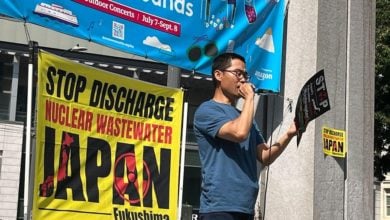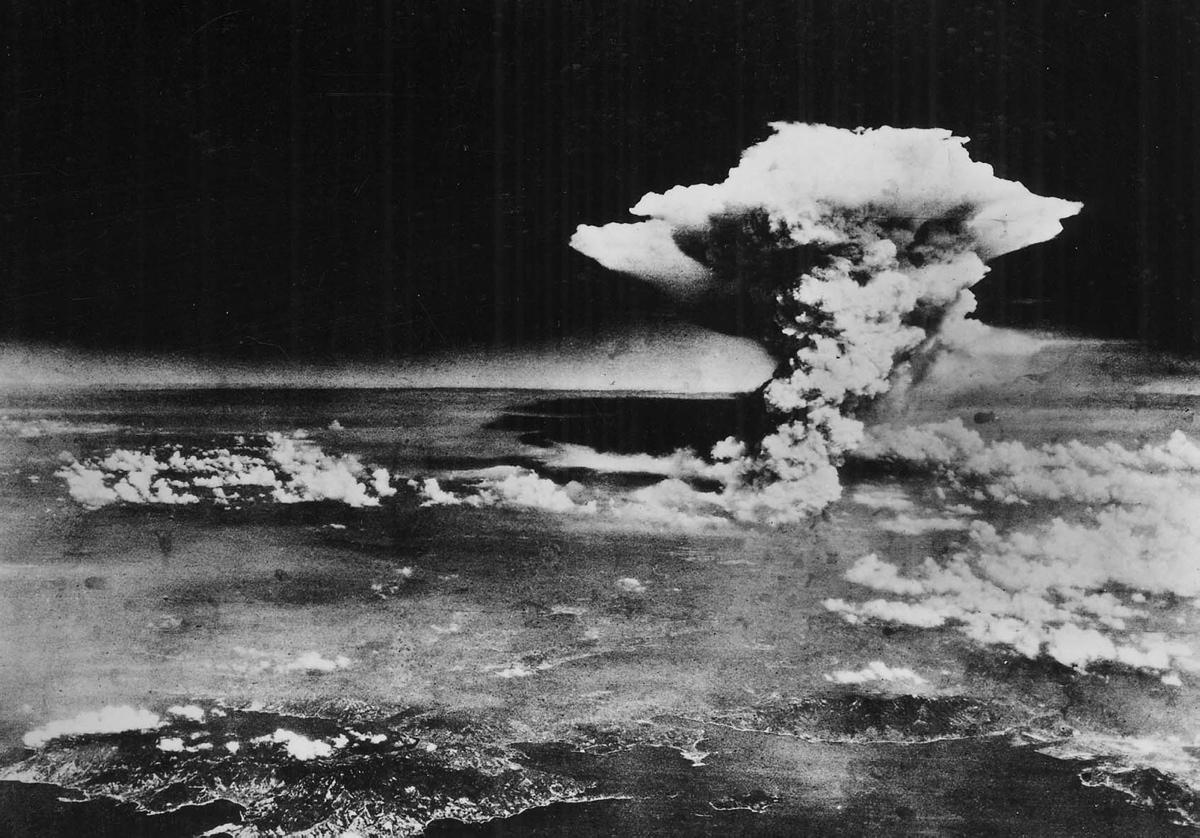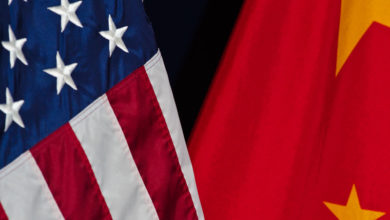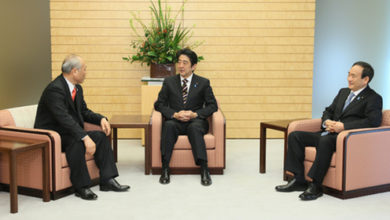 Nuclear cloud over Nagasaki, August 9, 1945. Photo: Jazz Editions/Gamma |
August 6 and 9 of this year mark the 60th anniversaries of the nuclear bombings of Hiroshima and Nagasaki. Numerous historical and personal accounts will emerge in the press, recounting the destructiveness, inhumanity, and long-term misery created by the two U.S. bombs.
Nuclear weaponry, as an indiscriminate killing force responsible for unspeakable atrocities, is truly weaponry of a different type. Many accounts will attribute the horrific bombings to the cruel pragmatism of U.S. generals, or the ignorance of White House decision makers. Some will defend the bombs as an unfortunate example of military expedience. Ultimately—we will be reminded—the bombs compelled an immediate Japanese surrender and achieved the victory over fascism.
But these explanations only scratch at the surface. While it is true that the bombings of Hiroshima and Nagasaki were murderous, terrible and cruel crimes, they are best understood not as the end of World War II, but as the beginning of a new war and an altogether new historical era. What some refer to as the “Cold War,” in fact began with nuclear incineration and massive human casualties. The bombs directly targeted Japan, but politically took aim at the Soviet Union, the worldwide communist movement and those colonized people fighting for national liberation.
From ally to enemy
The Soviet Union had been a U.S. ally in World War II, and lost an estimated 28 million soldiers and civilians—far more than any other nation—in the fight against fascism. Its reputation was at an all-time high in the United States. In public, the White House had nothing but praise for their Soviet allies. At the Battle of Stalingrad (ending in February 1943), the Soviet Union had done what the U.S. military and Britain were unable to do—turn back the Nazis.
After Stalingrad, the fascist forces continued taking losses in Eastern Europe at the hands of the Soviet Union. Italy had surrendered in September 1943. Finland, Bulgaria and Romania capitulated in 1944 and Germany finally surrendered in May 1945. The world political situation had changed.
As the smoke cleared, a picture of the post-war world was emerging. The principal foreign policy objective had changed from the victory over fascism to the control of the conquered territories. In the Pacific War against Japan, the United States reoriented its strategy accordingly. When the United States dropped the atomic bombs, the defeat of Japan—at that point a country on the defensive and without allies—was imminent. The main question was: who would preside over their surrender?
Japan’s imminent defeat
People in the United States refer to the period of 1941 to 1945 as the “Pacific War,” but in China it is called the “War of Resistance Against Japanese Aggression”—and that resistance began much earlier. This is no accident. For decades Japan aspired to control China, invading the eastern Chinese province of Manchuria in 1931 (while the League of Nations stood idly by) and major cities in 1937. Japanese imperialism faced stiff resistance in China, particularly from the communists, and in response massacred entire cities. The United States was formally neutral, still trading with Japan, but threatened by its colonial aspirations.
When Japan entered into an alliance with Nazi Germany in 1941, the United States and Britain cut off its trade of oil and steel to Japan, thereby bringing its growing war-machine to a halt. In need of more raw materials, and interpreting the Western blockade as an act of aggression, Japan invaded colonial Pacific outposts of Britain, France and the United States, and attacked Pearl Harbor. The day after the Dec. 7, 1941, Pearl Harbor attack, the United States declared war on Japan.
The Japanese imperialists expanded their reach all over the Pacific. By late 1942 and early 1943, however, the Allies launched several successful offensives that re-captured many important Japanese outposts. This created staging grounds for the Allied forces to launch a final offensive on mainland Japan, and eliminated the raw materials that had been supplying the Japanese military. Meanwhile, the Chinese liberation struggle waged on with increasing ferocity.
Towards the end of the war, the Allies began to bomb dozens of Japanese cities, often with new destructive weapons. As they had done in Dresden, Germany, weeks earlier, the United States fire-bombed Tokyo, killing 100,000 people. The United States called for nothing short of unconditional surrender from the Japanese. Throughout their bombing campaign of the spring and summer, the United States military had left a few Japanese cities untouched. Two of them were Nagasaki and Hiroshima. On those cities, they wanted to test their new invention—the atom bomb.
Meanwhile, the Japanese ruling class was split. The military leadership wanted to fight on, but the “civilian” politicians pressured the Japanese emperor to negotiate for a peace treaty. They quietly opened diplomatic communications with the Allies, which implied that the military sector might accept a conditional surrender (with conditions like maintaining the emperor).
The U.S. government intended to maintain the emperor in its post-war reconstruction of Japan, but before it made any diplomatic moves towards peace, it first wanted to use its new weapons. General Dwight Eisenhower, one of President Harry Truman’s closest advisors, argued that Japan would soon surrender without the atomic bombs. Numerous historians have likewise argued that the atomic bombs were unnecessary from a military standpoint.
The political situation, however, compelled U.S. imperialism to act. In February 1945, the Soviet Union finally agreed to open a front against Japan. At that time, the United States and Britain believed only Soviet intervention could lead to a rapid Japanese surrender. The war in Europe ended in May, and the Soviet Union was preparing to enter the Pacific War in August.
Although they had initially courted Soviet intervention, by July the United States had successfully tested the atomic bomb and began to hope Japan would surrender before the Soviet Union arrived. With the Soviet Union preparing to invade through China, the U.S. government dropped the first bomb on August 6 on Hiroshima, killing 80,000 people instantaneously. President Truman, who ordered the bomb, defended it as a way to bring about surrender and save U.S. military lives that would have been lost in a ground invasion of Japan.
The Soviet Union declared war on Japan on August 8, and the following day the United States dropped the second atomic bomb on Nagasaki, killing an additional 100,000 people. The massive Soviet invasion, as well as the devastation caused by the atomic bombs, caused Japan’s ruling class to finally surrender on August 14. Hundreds of thousands of Japanese civilians either died or suffered disease and deformity from the bombs’ radiation “fallout” in subsequent years.
The worldwide communist movement
In 1944, the Red Army of the Soviet Union rolled through Eastern Europe liberating nation after nation from fascism. The Soviet Union defeated the most hated governments in the world, and the prestige of communism soared. The Western capitalists naturally opposed the spread of Soviet power, but couldn’t do anything about it at the time.
 A U.S. nuclear bomb destroyed the city of Hiroshima. August 6, 1945. Photo: Epa Photos |
It would be false, however, to simply attribute the spread of communist influence to the Red Army. The European working class was well aware that the capitalists in their own countries either promoted or collaborated with the forces of fascism throughout the first half of the 1940s. Nearly all of continental Europe fell under fascist domination. The communists throughout Europe and Asia had proven themselves to be the most courageous fighters and defenders of their homelands. On those grounds, the communist movement emerged as the dominant political force in many nations, with the Soviet Union functioning as its natural center of gravity.
From 1935 through the end of the war, the Austrian communist party grew tenfold (to 150,000) and the Czechoslovakian party almost twenty-fold (to 1,160,000). The Finnish party won 25 percent of the vote in 1945. In Greece, the communists were the dominant political force; the Yugoslav party directed a vast army renowned for vanquishing the German fascist invaders. Yugoslavia was the only country in Eastern or Central Europe to defeat the Nazis without the direct intervention of the Soviet Red Army.
Where the Soviet Union did not have a military presence, the communist parties still grew tremendously. The French party had over a million members, and the Italian party had over two million. The Belgian party grew tenfold, and the Danish party tripled. Capitalism was tottering.
The United States and Britain only partially recognized the organic nature of the communist movement, instead attributing it to Soviet conspiracy. The resistance fighters in many nations indeed looked to and forged relationships with the Soviet Union, but those relationships often had a moderating, rather than radicalizing effect on those parties.
To assure his allies that he was not planning revolution in their countries, Soviet leader Joseph Stalin dissolved the Soviet-led Comintern in 1943. The Comintern (the Communist International) was an organization founded by Lenin and the Bolsheviks in 1919 to bring together communist and workers’ parties throughout the world to promote socialist revolution.
The tendency to avoid a new war with the capitalist Allies increased after World War II and the dropping of the atomic bombs. The Soviet government, above all else, wanted a respite, a breathing space from military conflict so that it could repair and rebuild the country’s devastated economy and infrastructure. The use of atomic weapons by the United States, and the ratcheting up of the threats against the USSR immediately after the close of World War II, compelled the Soviet leadership to divert an enormous part of its economic redevelopment program to the military.
Fearful that the United States would turn its atomic weapons against a non-nuclear USSR, the Soviet leadership poured vast resources into its own nuclear program. Contrary to Cold War mythology, the Soviets pursued a defensive posture in the post-war years. Spreading socialism and revolution in Western Europe was not the aim of the Soviet leadership. Their goal was to mitigate the U.S. war drive and to prevent the initiation of new conflict.
In 1949, the Soviets successfully detonated their first nuclear bomb, but were only able to achieve a significant nuclear arsenal in the mid-1950s.
The communist parties in Italy and France, having led the anti-fascist struggle during the war years, developed a mass base in the working class and among the peasantry. They had developed large armed forces that functioned as the indigenous resistance against Nazi occupation. Instead of pursuing a policy of armed struggle in order to carry out a socialist revolution immediately after the war, these parties laid down their weapons and entered the electoral process. This policy was backed by the Soviet leadership, which feared that a socialist revolution in Italy or France would trigger a nuclear attack by the United States against the USSR.
In Greece, the powerful communist party pursued an independent path of armed struggle against the British-backed capitalist government. The Soviet leadership did not provide material support to the Greek communist resistance, which was eventually destroyed.
Atomic diplomacy
While the Soviets acted to muffle socialist armed struggle in Europe following World War II, the situation was altogether different in Asia. The revolutionary forces fighting Japanese and European colonialism took the offensive in North Korea, China and Vietnam.
 The Soviet Red Army liberated Eastern Europe from fascism. Berlin, April 30, 1945. Photo: Itar-Tass |
Japan was occupied and rehabilitated as a U.S.-friendly government in order to counteract the spreading socialist revolution. The United States seriously considered using nuclear weapons in China, and had come to a decision in 1953 to “nuke” areas of North Korea, if the Korean War continued to go badly. On countless occasions, the U.S. government used nuclear threats as part of its new “atomic diplomacy,” which became a central tenet of its aggressive, imperial foreign policy.
Although nuclear weapons were popularly considered a means of “mutual deterrence,” the U.S. government in fact developed them as a means for first strike attack against non-nuclear countries. Michio Kaku and Daniel Axelrod have written, “Most Americans assume ‘deterrence’ means to deter the Russians from a nuclear attack on the U.S. But what the Pentagon intends is to ‘deter’ other, often weaker, non-nuclear nations from interfering with U.S. interests by threatening them with escalation to ‘the utmost levels of violence.’”
The U.S. government’s current hostile posturing toward Iran and North Korea upholds Kaku and Axelrod’s thesis. U.S. threats against these countries, and others like them, are a continuation of this misnamed “deterrence” policy, which took form at the end of World War II.
The nuclear weapon has been, from the very first time it was dropped, the military and political weapon of U.S. imperialism.






